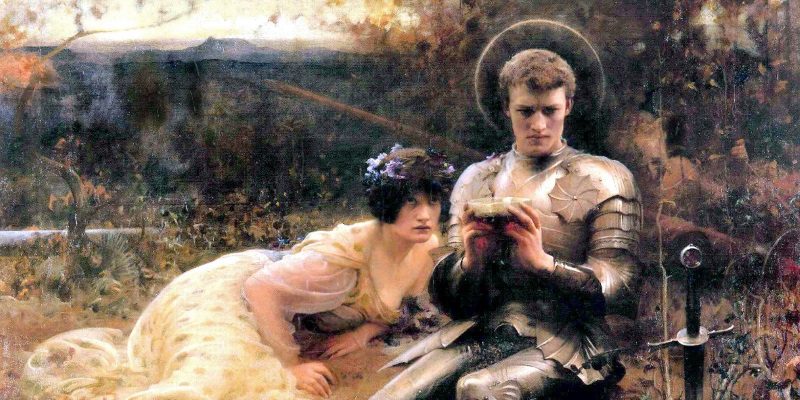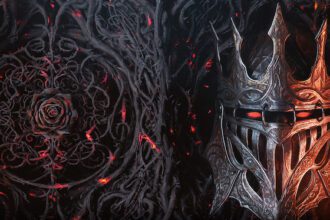The Paladin Class, Part Seven

To be honest, when I started this series I never would have guessed that I would need seven articles to talk about one class. On the other hand, D&D has a long and nuanced history, including a lot of offshoots, clones, retroclones, demi-clones… so today I’m tackling three of those not-quite-mainline iterations: the Rules Cyclopedia (OD&D), Pathfinder (3.x, but honestly if you read gaming websites you don’t need me to tell you this), and 13th Age (4e…ish).
(Part Eins, Zwei, Drei, Vier, Fünf, Sechs)
Rules Cyclopedia
The Paladin of the RC has very little in common with even its OD&D predecessor. It is something more like a fighter-only Prestige Class. In the RC, a 9th level fighter might go one of four different ways. The first decision point is whether or not the fighter can secure a land grant; if so, she becomes part of the ruling nobility and might advance that way. If not, the fighter is a “traveling fighter,” and might be a Paladin if she takes vows with a Lawful clerical order, an Avenger if she takes vows with a Chaotic clerical order, or a Knight if she does neither.
The Paladin gains a number of magical class features and restrictions:
- The real surprise is that lay on hands isn’t one of them. I am pretty sure this is literally the only version of the Paladin I have ever seen (not counting anti-paladins of one kind of another) that does not have an ability specifically called lay on hands.
- They do still get clerical spells and can heal that way, of course, if they have a Wisdom score of 13+. This spellcasting scales, so that the paladin casts spells as a 12th-level cleric when she reaches the 36th level of fighter. I suspect that very few RC campaigns run all the way to 36th level, but for those that do, gaining access to 6th level spells is no joke.
- Detect evil, 120’ range, at will.
- Turn undead, same scaling as clerical spellcasting.
- Fealty and obedience to a Lawful (which is roughly the same as Good in the RC) clerical order. In general it means “pro-social,” and Chaotic means “anti-social,” more than having anything to do with law, personal liberty, or the like.
- Restrictions on the number of hirelings – which again scales just like clerical spellcasting.
- Obligation to help anyone who isn’t evil, or asking you to do something evil, and if you’re doing something more important, your help can be pretty minimal.
These class abilities are tame enough, overall, that they’re mostly interesting by contrast with the Knight and the Avenger. The Knight is technically a safety school for anyone who can’t hack it as a paladin or avenger, or who stayed Neutral; it gets no magical abilities at all, but has the right to request hospitality in exchange for a lengthy list of obligations to a liege lord – obedience, service in wartime, and severe punishment for any infraction. It would be an unusual setting that made the right of hospitality valuable enough to balance all of those obligations, but I guess if you’re playing in a time of anarchy, or in Westeros, it comes close.
Then there’s the Avenger, the Chaotic opposite number of the Paladin.
- Clerical spellcasting, as with the Paladin, but derived from a Chaotic clerical order. They’re just as obliged to serve the Chaotic order, but they might also have to pay a huge amount of money for the privilege of learning clerical spells – by 36th level, 60K gold pieces (or 120K, depending on interpretation).
- Detect evil… which is strange considering how sinister the Avenger is.
- Turn undead, except they also have the option to Control the undead.
- Instead of human or demi-human hirelings, Avengers can attempt to gain Chaotic monsters as hirelings. The system here is tricky and has a lot of ways to go wrong for the Avenger, but having a coterie of monsters at your beck and call is really cool.
- The right to demand hospitality from Chaotic monsters or people, and the ability to potentially trick other landholders into granting him hospitality.
- This ability is simply fascinating – a sinister warrior who can stroll into any old monster lair and expect to be granted Sanctuary says a lot of strange things about the setting. It strikes me as something that might work for a black knight in certain Arthurian romances. I love that it suggests a relatively stable shadow-society of monsters and black knights beyond the borders of civilization. It throws the hospitality rights of the Knight (and the absence of any such ability for the Paladin) into sharp relief, though it also raises a lot of questions during setting creation.
Making all of these fighter variants something that you progress into, rather than starting points, fits the broader fiction very well. It’s a way that other editions can work, perhaps with variant rules, but I wouldn’t care to see it become the new default. I would like to see more games really drill down into making the rules follow the fiction in this way – but then you have the Avenger, and I still don’t know quite what fictional model it is following. It would drive me crazy to see more D&D-lineage games treat the first eight levels as the “training” levels, because that’s usually months or years of play. Working toward a goal is good, but far too many campaigns fizzle out before the PCs could ever reach the carrots that the game has been dangling, and when that happens in multiple successive campaigns, it’s incredibly disappointing.
Pathfinder
The Pathfinder Paladin is thematically pretty close to the 3.x Paladin, but there’s a lot more going on mechanically. I hesitate to get into an itemized breakdown of the class, but I’ll try to hit some high points.
- Smite Evil received an overhaul to make it much more potent: it grants the same bonuses to attack and damage, doubles that damage bonus for evil outsiders, dragons, and undead, and keeps going until you kill that one target. In a sense, it’s a much more powerful version of 5e’s hunter’s mark or hex, and the paladin can eventually do this seven times per day. It’s a vast offensive boost.
- At 11th level, the paladin can sacrifice some per-day uses to share this ability with non-evil allies.
- Lay on Hands also got a big boost, and if you really focus on boosting Charisma, the paladin becomes a pretty amazing healer. The number of uses per day and the number of d6s of damage healed both scale with level. The paladin can alternately use this to damage undead with a touch attack – so this can also be an offensive boost.
- Lay on Hands uses per day are also the currency for the paladin to channel positive energy.
- Mercies are additional benefits tacked onto the paladin’s Lay on Hands usage. By 12th level, the paladin has picked up four separate effects (chosen from separate lists) of her Mercies.
- Instead of a steed, the paladin might gain a weapon bond, which is a short-term but quite substantial boost to the paladin’s weapon. The duration, bonuses granted, and uses per day all scale with level, up to a total “bonus pool” of +6, four times a day, for twenty minutes per use, at 20th level.
- They get a bunch more auras, all of which sound like a lot of data to track to me. In general, the auras make the paladin immune to something and make nearby allies much more resistant to it. They also gain DR 5/evil, which bugs me thematically – why are they less powerful when something is Really Truly Evil, which seems like the time they would most want the benefit?
- At 20th level, the paladin becomes a holy champion and increases their DR to 10/evil, with a chance to inflict banishment whenever using Smite Evil. I might be misreading this, but if you really want something dead rather than banished, this might be a drawback rather than a benefit.
Thematically, the only shift I see here is a potential increase in healing output; it feels to me like a paladin could expect to be the party’s main healer, if purpose-built to do so. I give a thumbs-up to any dedicated effort to share the primary-healer role to classes other than Cleric. This being Pathfinder, there are of course a huge array of variant progressions and alternate class features to choose from, though I’m not sure that there’s even as much thematic differentiation as the three Oaths of the 5e paladin.
The excellent thing that I see here is that there are a lot of different ways to use the class’s per-day abilities. Your primary healing resource can also be a channeling resource or a damage-to-undead resource, and you can obviously focus on personal survivability or team survivability. Your primary damage resource can also be a group-leadership resource. The healer, the avenging angel, and the defender are all just different choices made with the same currencies. As a result, your round-by-round decisions express just what kind of paladin you are, more so than other iterations of the class.
13th Age
Finally we come to 13th Age, which takes some inspiration from the rules of 4e even if it is not as close a relative as Pathfinder is to 3.x. If you haven’t explored its design, some of this won’t make a ton of sense, because it really is doing its own thing. The other somewhat-similar game to it is Dungeon World, if you look at the Advanced Moves in DW’s playbooks and squint a bit. (Dungeon World’s paladin would be worth a post too, but I have got to stop talking about paladins at some point, y’all. The Warlock is getting irritable and wants to be the center of attention, because of course he does.)
But I digress. The 13th Age Paladin is a high-toughness melee brute, with a really nice limited-use damage kicker in the form of Smite Evil. All of their other abilities are chosen from a list, and most abilities have one or more feats that improve them incrementally. (Feat design in 13th Age is, as a result, almost the opposite of what the 5e designers did, but they’re both really good for what is ironically the same reason – they’re presented without complicated pre-requisites and with easy-to-understand impact on gameplay.)
- Smite Evil has both per-combat and per-day usage, which is a great design choice – you can choose to “go big” in this one battle, but you’re not out of luck for all later battles in the day.
- Bastion improves the paladin’s defenses and lets them defend their allies by taking part of the damage. Take this to be more of a defender.
- Cleric Training lets you use some cleric spells. Quelle surprise!
- Divine Domain gives you another way to class-dip into Cleric.
- Fearless grants immunity to fear and rewards you (with an accuracy bonus) for behaving fearlessly. Immunity aside, I like the sense of reward.
- Implacable factors into the effect resolution of the turn order to let you shake off conditions.
- Lay on Hands works a lot like the 4e Paladin. Unless you buy all three of its feat upgrades (and maybe not even then), you’re not going to cut it as a primary healer, but between this, Cleric Training, and Divine Domain, you could probably get there. It costs the paladin more to do that than it would cost the Cleric, but it might be an interesting build.
- Paladin’s Challenge is similar to 4e marking abilities, with similar issues of complicated wording. Still, it’s a pretty solid way to influence the actions of one opponent.
- Path of Universal Righteous Endeavor and Way of Evil Bastards are mutually-exclusive abilities to make you either a Good paladin or an Evil paladin. (You can go your whole career without taking either of these.) They grant kind of lackluster benefits, but the feats that branch off of them have a lot more to offer and interact with 13th Age’s Icon system, which might be a really big deal – I suspect that varies a lot from table to table.
What we see here is a paladin that can be a defender, an aggressive smiter of evils, a nigh-invulnerable juggernaut, or a healer – but not all of those. Pick one task at low levels, and maybe branch out into two at higher levels, or become a broad-based generalist. Area-effect damage is the one thing I wouldn’t look to any paladin to do well, which is fine. The core book of 13th Age doesn’t set out to carve out new thematic space in the classes; instead, they went out of their way to cover the traditional territory with new and highly functional mechanics. Of all of the paladins in this article, this one gets top marks for clarity of presentation and matching up to the traditional archetype. Compared to other classes within the game, the paladin is one of the most straightforward, with the least variation in round-by-round options. This slightly undermines the feeling that they are a blend of fighter and cleric, as the 13th Age fighter distinguishes itself through its many options for maneuvers and the varied triggers for those maneuvers.
Conclusion
So there you have it: paladins. They are one of my favorite archetypes, because I enjoy characters who face moral and ethical challenges. Tune in next week for the exact opposite type of character: the warlock, a reprobate, villain, and scoundrel that has already bargained away his soul, so now he wants yours, too.



